Anyone who’s seen Harold and Maude more than once begins to notice interesting tidbits and trivia.
The screenplay for Harold and Maude was Colin Higgins’ thesis for the UCLA screenwriting MFA program. The professor teaching the course told Colin that Maude should live in the end. The original screenplay and a Harold and Maude novelization were both written by Higgins.
The drowning suicide in the novel describes Harold putting together a small breathing apparatus, an aqualung device which he concealed under his clothing. This was later put to use when Harold and Maude staged Maude’s death to stop Harold being drafted into the army. She uses the device when she falls through the hole and into the water.
Maude’s picture frames are empty in Colin Higgins’s novel. Harold asks why she removed the photographs. Maude tells him they mocked her by their images remaining sharp even as her memories were fading as she ages. The scene was not used in the movie.
There is a deleted scene from the novel in which Mrs. Chasen talks with Harold’s dummy, mistaking him for her son. It is described in detail in the novel.
A play based on Colin Higgins’ story opened in New York on February 7, 1980 but failed badly, closing on February 9, 1980 after only 4 performances. The stars were Janet Gaynor, Keith McDermott, with Ruth Ford playing Mrs. Chasen.
When she first meets Harold, Maude states her full name as Dame Marjorie Chardem (although it is spelled “Chardin” in the screenplay, novel, and transcript).
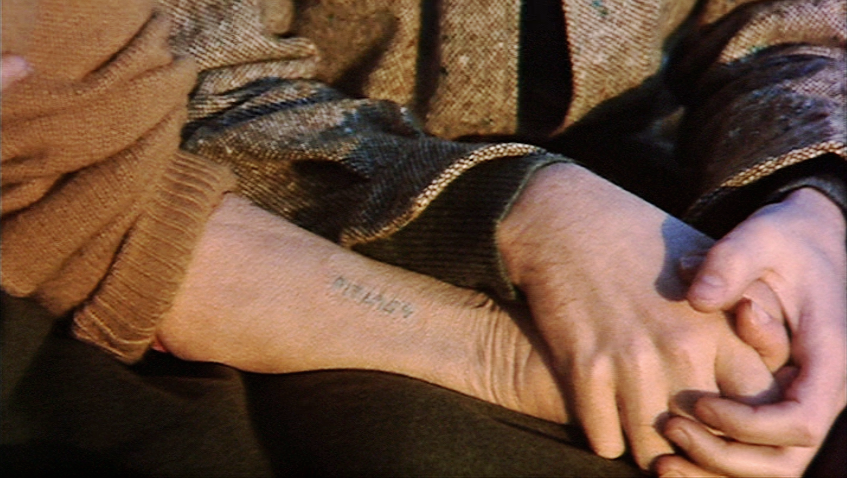
To avoid an ‘R’ rating, a controversial swear word had to be eliminated from the scene in which Harold and Maude sit watching the sunset. The concentration camp tattoo on Maude’s arm which only appears for an instant, is something that many people miss the first time they see the movie. When Harold looks at her tattoo, she pulls her arm away from him and points to the sky, and tells him that you can see beautiful symbols of freedom like seagulls even in the worst moments of your life.
One might think that perhaps we’re supposed to infer that she is a Jew, liberated from a concentration camp but another interpretation believes it is just as likely that Maude was imprisoned by the Nazis because it was in her nature to resist tyranny, just like she does in America.
When Maude sees a flock of seagulls she explains, “Dreyfus once wrote from Devil’s Island that he would see the most glorious birds. Many years later in Brittany he realized they had only been seagulls. For me they will always be glorious birds.”
Alfred Dreyfus (1859-1935) was a Jewish officer in the French army, wrongly convicted of treason in 1894, and sentenced to life in solitary confinement in a penal colony off the coast of French Guiana. He was pardoned five years later, and ultimately exonerated when the evidence against him was proved false.
Maude also lives in a train carriage, clearly subverting a symbol of the death camps (the means of transport used to deliver people to the camps), turning it into a shrine to freedom.
Director Hal Ashby and crew…

In the scene where Harold and Maude are at the amusement park and playing with the model train, the man with the long beard is director Hal Ashby. He mysteriously disappears in the next scene with the model trains.
During post-production, Paramount Pictures stripped Ashby of his power to edit the film. Thus, in solidarity with his director, Bud Cort told the film’s PR team that he wouldn’t do any publicity for the film unless Ashby got his movie back. According to The Guardian, control over the footage was handed back to Ashby—save for a kissing scene between Harold and Maude that Paramount head honcho Robert Evans despised.
Bud Cort’s method acting techniques sometimes clashed with the more classically-trained cast. During a scene in which his screen mother, played by Vivian Pickles, tells him he’s going to be joining the army, he slowly raises his middle finger, sucks on it, then holds it up at her throughout her monologue. “She finished and ran off the set. Then Hal said, ‘Oh my god, Bud you can’t do that! It was great, but she’s pretty down, you have to apologize to her!'” Ashby later got Cort to give her the finger in a later scene.
Visible crew/equipment: When Maude pulls the banjo out of a cabinet, you see the reflection of crew and lights. Harold holds back a chuckle when visiting Uncle Victor for the 1st time. Girl smiles at funeral when Maude tries to capture Harold’s attention. About 50 minutes into the film, when Maude is doing donuts around the officer, the driver’s side window of the El Camino is alternately up and down between shots. When Harold and Maude are hauling a tree in the back of the car, in one shot of them driving away, the tree disappears (shot from behind), then it reappears for all subsequent shots.
The Cars…
The hearse Harold originally drives is a 1959 Cadillac Funeral Coach Superior Royale Landaulet that is one of the most sought after hearses among collectors today but at the time was considered nothing more than an undesirable used car which was purchased for a few hundred dollars. In all shots of Ruth Gordon (Maude) driving the hearse, it is being towed, because she never learned how to drive a car.
The grey OTS (open two seater) Jaguar roadster that Harold receives gift-wrapped is a 1971 Series 2 model. You can identify this by the small rectangular “leaper” badge low on the bonnet behind the front wheel; it was a one-year only addition to the car done in 1971.
The license plate on Harold’s Jaguar Hearse is a California temporary paper tag for new cars. These paper tags were taped on (usually on the bumper) until the real license plates were received from the DMV in the mail. These old style paper tags were only issued until the 1970’s, and do not resemble California temporary paper plates that are now issued since 2019.
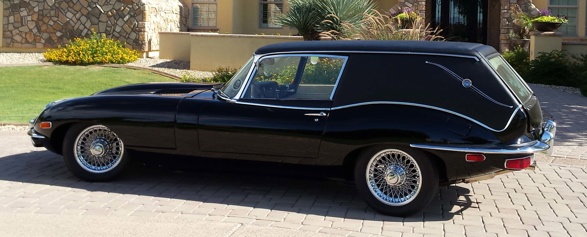
The scene in which Harold turns to look at the camera after successfully scaring off his first date, when he gives “the finger” to his mother behind her back as she sees the Jaguar turned into a Hearse, was not in the script. Rather, it was based on a previous improvisation added by Bud Cort.
The Jag-hearse hybrid car is a 1961 to 1965 Series 1 coupe. This film was shot on a tight budget, so there was probably not a lot of extra money to purchase a perfectly good car, modify it and then destroy it in the end. It would have made sense to locate an early, high-mileage coupe that could have damage coverable by the hearse back or was just on it’s last legs. Either way, there are way too many indicators that make it clear that it is a Series 1 coupe dressed it up to give it a passing resemblance to a Series 2 car, which is all that would be needed. Other than the 3/4 rear shot in the beginning, the shots of the car are mostly quick, at a distance very close up or obscured by trees.
The freeze frame of the Jaguar hearse in midair in the final sequence is the result of an accident. All cameras except for one froze up at that time, so only the one was left running. They had to use that shot, because they didn’t have another car. Since only one hearse had been prepared for the film, it was impossible to reshoot the shot. The Jaguar hearse really was destroyed at the end and no replica exists because they only constructed one version for filming.
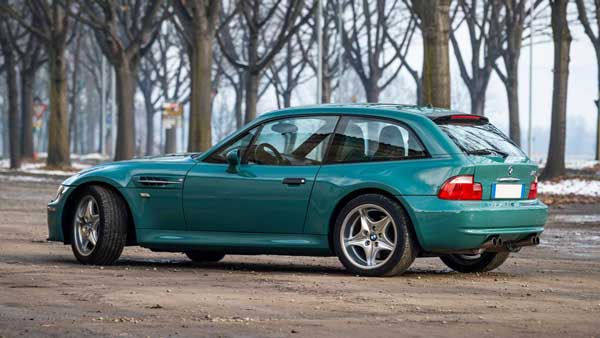
The Jaguar-hearse has been officially cited as the basis for BMW’s odd-looking little M coupe introduced in 1997. For several years now, critics have called the squat little toad just about everything but wonderful. It has the same insouciance as the wonderful scene where you see Harold’s handiwork coming off the jacks after he sparks off the torch and drops the mask. BMW’s designers have rather gleefully announced that their idea came from: Harold and Maude.
The Music…
Cat Stevens, the composer and performer of the original music for the movie, can be seen in one of the funeral scenes. He is the bearded gentleman wearing a hat and a full coat, behind which Maude hides after she tries to get Harold’s attention by hissing. The hitch hiker that Harold and Maude pass on the road when they are driving with the tree is also Cat Stevens.
Cat Stevens did not initially release “If You Want To Sing Out, Sing Out,” or “Don’t Be Shy” for public just so that more people would go to the theatre to see the film to hear those two songs. They were written just for the movie. He finally released them in 1984. Footsteps In the Dark is his only album that features them, and is also his only album that made a public reference to Harold and Maude.
A soundtrack album was released but only in Japan. You can get all of the songs from the movie on various Cat Stevens albums. His Classics Volume 24 is probably the closest thing to a soundtrack for the movie. It includes “If You Want to Sing Out, Sing Out”, “On the Road to Found Out”, “Trouble” and “Where Do the Children Play.” Other CDs with Harold and Maude songs on them include Footsteps In The Dark , Tea for the Tillerman, and Mona Bone Jakon.
Places worth mentioning…
The Westgate Theater didn’t have big audiences until the 1970s with Harold and Maude which opened in mid-1972, had achieved a cult following. For over two years, Harold and Maude played at the Westgate. By the beginning of the third year, disgruntled neighborhood residents picketed the theater with signs reading, “Our plea to Westgate. Your neighbors want variety” and “Two Years Too Much.” The record-breaking run of Harold and Maude brought it and the stars Ruth Gordon and Bud Cort national acclaim. Cort said later that the Minnesota run would boost his career. Both stars visited the Westgate Theater. Ruth Gordon attended the first anniversary showing, and both came for the second anniversary, as picketing continued. The movie played for a total of 1,957 showings from mid-1972 until June 1974, setting a new record for number of showings for any movies in the Twin Cities.
Maude’s home, a Western Pacific Lounge 653 railroad car, was known to be parked at Oyster Point. It was leased from the Western Railway Museum at Rio Vista Junction in Solano County (about 60 miles east of San Francisco) and moved to its filming location. As a lounge car built in 1931, it had seen years of service. When the studio painters arrived to install the fake fireplace shown in the film, they had the mean job of matching interior paint colors. “Jesus.”, said the head painter, “This is years of nicotine on the paint. How am I going to match this crap?” When filming was finished, the car returned to the Museum. And, yes, the fake fireplace still survives but is no longer mounted inside the car.
When Harold comes to Maude’s for oat straw tea and ginger pie, she leaves the room when the kettle starts to boil. Harold tries for a moment to stick his head through the wooden sculpture that Maude has told him to “caress: and explore.” The entire movie is about rebirth, in a way, and this scene is a “tactile” example of that, as Harold tries to put his head through the vagina-like sculpture.
The Chasen Family Mansion is actually the Rose Court Mansion in Hillsborough, California, south of San Francisco. The butler in the film (Henry Dieckoff) was the actual butler of the house. The original script called for him to drop the lemonade tray after “Sunshine” does her Juliet imitation, but the butler thought it unbutler-like, and so Vivian Pickles had to do it.
The scene at the amusement park where Harold says that a ride “wasn’t very scary,” was at the “Trabant” located at the westernmost end of the Santa Cruz Boardwalk, nearest the Casino Arcade. It was replaced with a giant “pirate ship” ride. The ride operator in that scene (he wears sunglasses — at night) was played by a guy who was, instantly recognizable to Santa Cruz locals. Any kid who ever worked there probably suffered having him for a boss.
The emergency ward at Peninsula Hospital, filming took all night long, and there were a whole bunch of fresh flowers there that they kept replacing, as the one in Maude’s hand kept wilting throughout the night. During the “Trouble” scene near the end of the film, you can read some of the words Harold is mouthing to the nurses. I think one of the things he says is “Can’t you do something? she’s dying!” and another was “I have Money!”
The Motorcycle Cop…
Most people aren’t aware that the motorcycle cop that stops Maude a couple of times was played (unaccredited ) by Tom Skerritt of the movie M*A*S*H and TV show Picket Fences. Skerritt says he was there when Ashby received the script for Harold and Maude, and it was Skerritt who suggested that Ashby cast Bud Cort, with whom he had worked in M*A*S*H , as Harold. “Ashby knew that this movie was way ahead of its time,” Skerritt says. “It wouldn’t be a hit right out of the gate, but it would become a cult film. Ashby knew all this from that first day.”
Skerritt’s small role in the film, as an authoritarian motorcycle policeman, came about by accident when a previously cast actor broke his leg. Skerritt’s film credit reads M. Borman, a reference to prominent Nazi official Martin Bormann, whose post-World War II whereabouts were still unknown. “I said one day that he probably came out to Oakland and became a motorcycle cop, and so that’s the way they put it in.”
The motorcycle is a 1971 or so Moto Guzzi Ambassador 750 (manufactured in Mandello del Lario, Lake Como, Italy). Occasionally used by Police Departments, they are now valuable collector items and sell for more than when they were new.
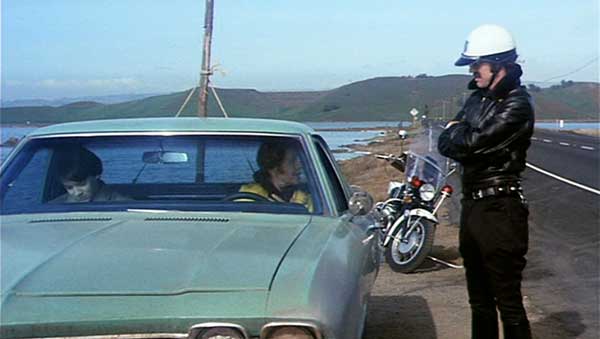
When the cop tells both Harold and Maude to get out of the car, Harold may be is getting out his checkbook. But he doesn’t have a chance to bribe the poor, unfortunate officer before Maude and he drive off with his motorcycle. Harold’s father had bribed the police after the rubber water wing incident. Others disagree saying it looks like he is taking out his wallet to give the cop his drivers license as he knows that Maude doesn’t have one.
When Maude gets on the cop’s bike and says, “Grab the shovel Harold!” he does so and bops himself in the forehead with it while getting on the back of the bike He lets out a little squawk when he does it! none of which was in the script. Bud said that it hurt like hell, but he didn’t want to ruin the shoot.
Also, Tom liked to improvise, while Ruth always insisted on saying the lines exactly as written. If you listen to their exchanges, you can tell that some of the replies she makes to him have nothing to do with what he just said.
Philosophy..,.,
When the film came out, though, it met with scathing reviews, bombed, and vanished from mainstream cinemas within a week. “You couldn’t drag people in,” producer Charles Mulvehill told critic and author Peter Biskind. “The idea of a 20-year-old boy with an 80-year-old woman just made people want to vomit. If you asked people what it was about, ultimately it became a boy who was fucking his grandmother.”
During the first funeral scene in the church when Harold and Maude first meet, she says: “…at 85 you’re just marking time.” Then they walk out the church door and a marching band is going by. The leader of the marching band blows on the whistle 3 or 4 times, which is called “marking time”.
Camus argued that there is no meaning to life so go ahead and be absurd and meaningless and perverse but Maude argues that there was no meaning to life so go ahead and live it with love and compassion to the fullest because you have nothing to lose.
Regarding the scene in which Harold tells Maude that he wishes he could “be a daisy because they’re all alike” and Maude responds, “Oh, but they’re not. If you look carefully, some are bigger, some smaller, some lean to the left, some to the right. You see, Harold, I think that much of the world’s problems are because people who are this (she holds up the daisy) and yet allow themselves to be treated as that.” In the movie, the camera pulls back, revealing lookalike tombstones at a military cemetery and the wonderful Cat Stevens score eases in. With the photography and music, it’s actually a much more powerful scene in the movie than in the book.
Colin Higgins…
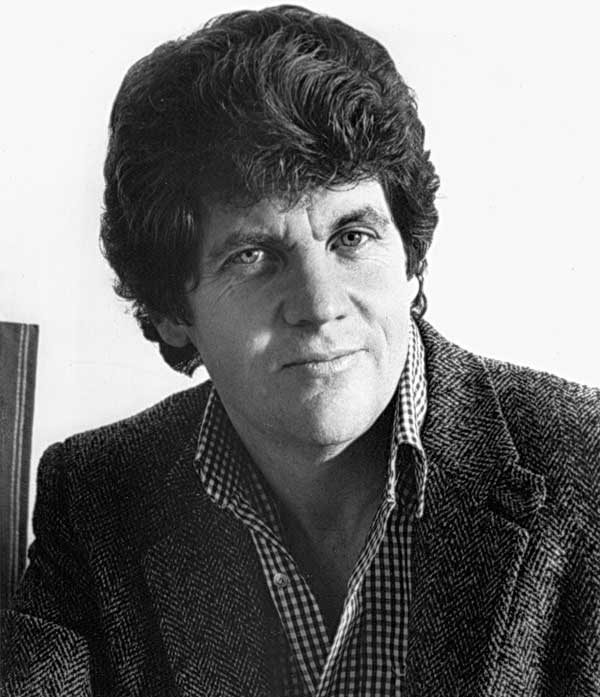
Colin Higgins was originally to direct Harold and Maude, but production was soon canceled. A couple of months later, production resumed when Hal Ashby was to direct.
Harold saying he enjoys being dead causes Maude to cheer, “They’re just backing away from life. Give me an L. Give me an I. Give me a V. Give me an E. L-I-V-E, Live! Otherwise, you’ll have nothing to talk about in the locker room.” This scene is the one Higgins was given as an test audition at Paramount when he was trying to become the director of Harold And Maude. Higgins later said that, in trying to impress Paramount, he felt he kind of rushed directing the scene and should have taken longer.
Colin Higgins being gay, perhaps allowed him to relate to the oppression that both Harold and Maude endured. He died at 47 years of age of AIDS. His memory lives on in the Colin Higgins Foundation which gives grants to people who have faced or fought bigotry.
